How To Grow Tomatoes Like A Pro
Learn how to grow tomatoes, from sowing to harvesting and everything in between with our complete guide.
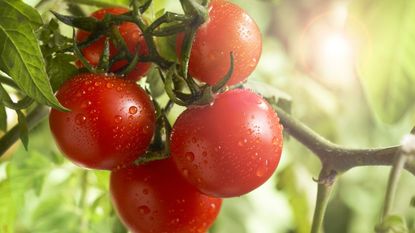

Learning how to grow tomatoes isn’t terribly tricky, but there are certain simple conditions that these summer vegetable plants demand and, if you aren’t sure what they are, you may be disappointed in your crop.
If you want to grow your own and don’t know where to start, you’ll find tips and facts here that will make it easy to successfully grow a crop of juicy tomatoes. We’ll walk you through the process, from choosing your seeds to harvesting the fruits, and we’ll even give you tips on how to propagate your tomato plants.
Starting Seeds or Buying Seedlings

Plan to start tomato seeds indoors at least 6 weeks before the final frost is expected in your area, or wait to purchase store-bought seedlings in the spring. Either one is fine, but there’s a certain satisfaction in starting them from seed.
When the soil in your garden has warmed up to around 55-60 degrees, you can introduce your tomato plant seedlings to the great outdoors. But first, make sure the soil is a bit acidy, around 6.2-6.8 pH, and that it drains well. And, since tomatoes thrive in full sun, plan for a sunny space in your garden spot or pot where they’ll receive at least six hours of sunlight each day. You can map the sun in your garden to help determine the best spot for your tomato plants.
When purchasing seeds or seedlings, you’ll see there are many types of tomato plants to choose from. The best strains for your particular region and summer temperatures are likely ones that are sold at your local garden centers. Read on to learn all about this incredible fruit, and which types will work best for you.
What Are “Determinate” and “Indeterminate” Tomatoes?
Don’t be intimidated by this term. When you purchase tomato seeds or seedlings, check the packet or tag to find out whether the plant is determinate or indeterminate. This will help you plan the space or pot you want to use for your crop. Here’s what it means:
Determinate Tomatoes
Determinate tomato plant varieties are bushy and relatively compact, while indeterminate strains have more of a vining tendency. How to tell the difference? A determinate tomato bush will stop producing shoots as soon as flowers form on the ends, but indeterminate varieties produce flowers and fruit along the shoots and will continue to grow until the weather begins to change in the fall. Determinate tomatoes can be grown in a tomato cage and are better at keeping bushy shape.
Gardening tips, videos, info and more delivered right to your inbox!
Sign up for the Gardening Know How newsletter today and receive a free download of our most popular eBook "How to Grow Delicious Tomatoes."
Indeterminate Tomatoes
Indeterminate tomato plants are rangier and often need staking to keep tomatoes from growing on the ground along the trailing stems. Obviously, they might require more real estate in your garden to stretch out.
Look at the instructions on your seed packet to decide in advance how much room and staking your particular variety of tomato is going to need. For example, grape tomatoes are determinate, growing bushy and producing quickly, while cherry tomatoes are indeterminate and will grow viney, but will produce fruit as long as the growing season lasts.
Once you’ve decided which of these works best, you’ll want to get your seeds germinating.
When And Where to Plant Tomatoes
If how to plant tomatoes is a mystery to you, rest assured it’s fairly easy. Plan for about 3 plants per family member to be sure there’s enough fruit to go around.
How to Start a Tomato Plant
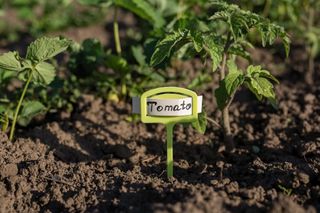
When growing tomatoes from seed, it’s best to sprout them indoors, in a greenhouse or other protected, somewhat warm environment. In small pots or germination trays, insert two seeds into damp potting soil about 3 times deeper than the size of the seed. Place the pots or trays in a warm spot that’s 70-80 degrees F (21-27 C) until sprouts form and keep them damp, watering at the base rather than getting the new leaves wet.
It’s great to keep the small sprouted plants under a grow light or near a sunny window until they’re ready to plant. If you see them getting leggy, it’s because they’re reaching for light, so be sure they have enough.
When to Plant Tomatoes

You may be eager to get them into the ground, but your little seedlings should grow to about 6 to 8 inches (15 to 20.5 cm) high, and have developed 4 to 6 real leaves before you transplant them to the garden or a larger pot.
The ideal growing temperature for tomatoes is relatively high. Your garden grown tomato plants won’t begin to produce fruit until outside temperatures reach 55 degrees F (12.7 C) or more, so it’s best to wait until night time temperatures in your region are staying above 50 F (10 C). If you wait until temperatures have risen sufficiently and your seedlings are at least 6 inches, they’ll be strong and ready to go into the ground or pot.
How deep to plant tomatoes? Don’t be afraid to plant them deeply in the soil, even up to the top set of leaves. If your seedling's extra stems are too long and floppy, try tomato trench planting: dig a furrow next to the main stem and gently lay the leggy part of the tomato in the trench and bury it, leaving its top two leaves above ground. Tomatoes love being planted deep, and will grow new roots along their stems, so don’t be afraid to really bury some of those straggly ones.
How Far Apart to Plant Tomatoes
Spacing tomato plants is essential. Your tomatoes need space, sunlight and air circulation as they grow. If they become too crowded they will rob the light and air flow from one another. Be sure they have at least 24 to 36 inches (61-91 cm.) between each plant, and space your rows about 4 to 5 feet apart (1-1.5 m). If you’ve planted vining tomatoes, give them more space: at least 36 inches (91 cm) apart, and keep the rows about 4 to 5 feet (1-1.5 m) apart.
Caring For Tomato Plants in the Garden
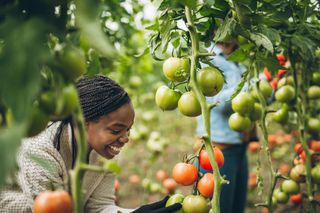
Light
How much sun do tomato plants need? Sun exposure is a crucial element in caring for tomato plants. Our experts say that six hours of direct sunlight is good, but eight is even better for a higher yield. Since tomatoes convert sunlight to energy, the more sun they get, the more they’ll produce.
Soil
It’s important to amend clay soil. Tomatoes can grow almost anywhere with the exception of compacted soil. A sandy, loamy bed of well-draining soil provides the most comfortable growing venue for tomatoes.
Tomatoes thrive in soil that’s slightly acidic. Your soil should test out at 6.2 to 6.8 pH. Soil tests are a great idea if you aren’t sure of your soil’s chemical makeup. For example, if your garden soil contains too much nitrogen, you'll likely have lots of green growth and blossoms, but no tomato fruit. If you can’t test your soil, at least work in a few pounds of a complete fertilizer (10-10-10) a couple weeks prior to planting tomato seedlings.
Watering

Newly planted tomato seedlings may need to be lightly watered every day until they are established. Watering tomato plants in the early morning is always best, since evening watering can lead to problems like fungus. Morning watering lets the plants’ leaves draw moisture throughout the day.
How Often to Water Tomatoes
How often to water established tomato plants depends on the weather. If your region is experiencing a hot spell, the plants may need a daily drink. However, in moderate temperatures, every couple days should be sufficient. If the soil is still moist an inch or two (2.5 to 5 cm) down, you may want to wait, but if your plants’ leaves begin to wilt, the surface soil becomes dry or the bottom leaves of the plants turn yellow, it’s time to water. But how to water them is even more important.
How Much to Water Tomatoes
Tomato plants require slow, deep watering at the base. With the exception of an occasional summer rain, the plants should never be watered overhead by a sprinkler system or hose. A slow dribbling hose or drip irrigation works best.
Don’t let your plants sit in completely dry soil, but be careful not to overwater them, either. The soil should stay moist but not soggy. If it rains heavily, give the plants time to absorb the extra water and check a couple inches down for moisture. If you’ve mulched around the tomato plant, pull the mulch away until the soil is a bit drier. Overwatering can be just as damaging as underwatering.
Mulching

Deemed the most popular garden crop in the US, tomatoes (Solanum lycopersicum) can be grown almost anywhere if they receive their preferred amount of sunshine, the right soil conditions and water. Learning how to plant tomatoes can for some be a trial and error process, but there are a few basics that will help get you off to a great start toward a bountiful crop of juicy tomatoes.
Using mulch for tomatoes is one way to assure they don’t dry out at the roots. There are many types of organic materials that work well for this purpose, including dried leaves, grass clippings, peat moss and straw. Mulching holds moisture in and is especially helpful in areas where summer weather grows extremely hot.
Fertilizing
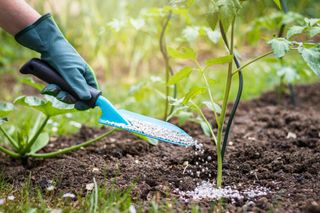
In the soil section of this article, we mentioned how a soil test can help with determining whether your soil is what tomatoes like best. Again, if you aren’t able to get your soil tested, treat it with a balanced tomato fertilizer. If your soil is correctly balanced or high in nitrogen, use a fertilizer slightly lower in nitrogen and higher in phosphorus, such as a 5-10-5 or a 5-10-10 mixed fertilizer. If soil’s slightly lacking in nitrogen, use a balanced fertilizer like 8-8-8 or 10-10-10. Choose organic fertilizers at your local garden center, or consider feeding your plants with fish emulsion, liquid seaweed or compost.
Fertilize your tomato plants after they’ve taken hold in the ground, about 2 or 3 weeks after planting. Give them one more dose of fertilizer when the fruit is beginning to set should be plenty. If you’ve been amending your garden soil over time, your tomatoes should thrive.
Staking and Caging
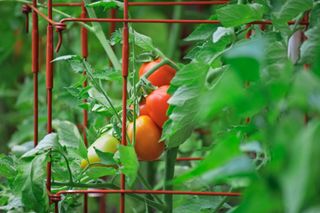
Because they can grow to be large and unwieldy, staking or caging tomato plants can help them grow strong, keep them off the ground and give them a solid support on which to lean and grow. Tomato fruits that lie on the ground are vulnerable to disease and other problems.
Is there a best way to stake tomatoes? It all depends.
One popular way to support a tomato plant is with a metal tomato cage. Cages work well when plants are fairly young, but some tomato plants will quickly outgrow a cage.
Tying the plant’s main stem to a bamboo, wood or metal stake will support the plant as it grows tall. However, it may bush out beyond that support and require staking of secondary stems and branches. When the plant has grown to around 1 foot (30 cm) tall, sink a stake approximately a foot into the soil around 5-6 inches (12-15 cm) away from the plant. Loosely tie the tomato plant's main stem to the stake.
Pruning
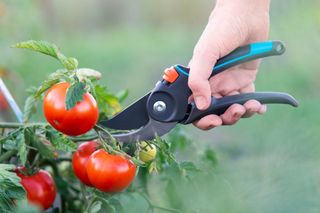
Here are some tips on how to prune tomato plants. Indeterminate tomato types, in particular, may become tangled and overgrown may require some pruning. Determinate plants should not require pruning.
Don’t prune your tomato plant until it has reached 1-2 feet (30-60 cm) tall. If you choose to prune them, make sure you’re watering the tomato plants at the soil level (like soaker hoses) rather than from above (like sprinklers). This will prevent the splashing of soil up onto the exposed pruning wounds.
There are varied opinions on how pruning will affect the crop’s outcome, so use your own judgment, but some experts say that pruning extra growth away from the plant will provide more energy for the fruit.
Undertake this project when the plant’s flowers are open or opening on a dry day. Using sanitized tools, remove any leaves, stems, suckers and fruit that look as though they may be stressed from disease or pests and discard the trimmings. Re-sanitize your tools, wash your hands and continue your pruning project by taking out any excess sucker stems, keeping in mind that some of the larger leaves are needed for shading tender fruits on days when the sun is particularly intense.
How to Grow Tomatoes in Containers
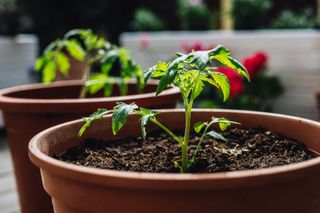
If you have a small space or just want to make your plants more portable, it’s a good idea to learn about growing tomatoes in pots or containers. In limited space, such as a balcony or porch, growing tomatoes in containers can be just as rewarding as they are from the garden.
Since each plant needs about 12 inches (30 cm) of space and plenty of soil, five-gallon (18.9 L) buckets with holes drilled in the bottom are great containers. You can also use wooden half-barrels, metal tubs or any large container with good drainage. Determinate tomato types are your best choice for container growing, since they will form bushes rather than vines. Plan ahead for supporting your plants with either cages or stakes.
When transplanting your seedlings to a container, mix in some organic material with your potting soil, such as wood shavings or compost. A great mix for potted tomatoes is potting soil, perlite, peat moss and compost. Be sure you’ve provided enough soil depth for your tomato plants’ roots to grow and stretch.
Containerized tomato plants require consistent attention to watering. Be sure the soil doesn’t dry out completely, but don’t over-water them, either. In the middle of summer they may need a drink every day. Prevent root rot by never letting your tomato plant sit in water or extremely soggy soil. When it rains, allow enough time for the excess water to drain before watering again.
Tomato Problems

For details on tomato plant problems such as disease, improper growing conditions and pests, there is a plethora of information within the link in this sentence. But the first task for the gardener is to diagnose the problem, examining leaves that have yellowed, curled or wilted and fruit that has anomalies. Tomato disease, tomato plant pests and environmental conditions can all wreak havoc on tomato plants. Also, check the plants’ environmental conditions, including sun exposure, correct watering and soil nutrients.
Use sterile tools to cut away leaves and stems that don’t look healthy and make sure to dispose completely of the trimmed material. As a first defense against pests, try saturating the plant with a horticultural soap, which can easily be made from home ingredients. Organic fungicides are available online and at garden centers.
Our best advice is to choose disease resistant tomato varieties. It should say so on the packaging, whether seed packets or seedling containers.
How to Harvest and Store Tomatoes

Harvest time for tomatoes is usually in late summer. Typically it takes about a month from the time it flowers for a tomato to be ready to pick.
What makes tomatoes turn red? Tomatoes are one of the few fruits that can be ripened after they’re harvested, so if you still have green tomatoes on the bush when cooler weather sets in, it’s fine to go ahead and harvest them. Pick tomatoes as early in the morning as possible.
Maturing tomatoes can be picked green when they begin to show a faint blush of color. Once tomatoes turn about half green and half pink, called the breaker stage, tomato plant ripening can occur either on or off the plant with no loss of flavor.
Vine ripened fruit may be sweeter, but often tomatoes grow too heavy to leave them on the plant, and harvesting them while green allows you to store them for longer.
It’s easy to ripen tomatoes once they’ve been picked. Bringing them into a dry space and placing them in a box or paper bag will let them naturally turn red. If you need a tomato to ripen more quickly, put it in a dark container like a paper bag along with a ripening banana. Mature green tomatoes will usually ripen within a couple of weeks in warmer temperatures (65-70 F or 18-21 C), and about a month in cooler temperatures (55-60 F/13-16 C).
To slow down tomato ripening, wrap the clean, dry fruits individually in newspaper and place in a box that’s stored in a cool dark place. Bringing the fruit into a warmer temperature will hasten the ripening process.
To pick a tomato, grasp the fruit firmly, but gently, and pull from the plant. Holding the stem with one hand and the tomato with the other, break the stalk or snip with garden scissors.
Propagating Tomatoes
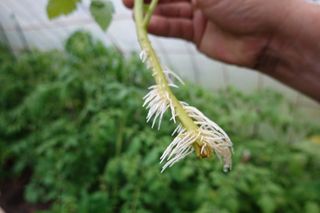
In addition to starting or purchasing seedlings, starting tomato cuttings from existing plants is also possible. Take a 6-8 inch (15-20 cm) piece of a tomato plant sucker off the top of a favorite plant. Clip off blossoms, buds and bottom leaves, leaving only 2 leaves on the cuttings and place it in water or potting soil. If starting it in soil, bury it up to the first node where you removed extra stems.
The cutting will grow roots in about a week in water; the roots will be stronger if started in soil. Transplant tomato plants into the garden or container when they’re a few inches tall and have developed a 3-4 sets of leaves.
Frequently Asked Questions
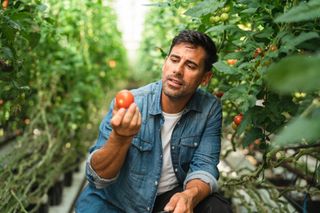
Can tomatoes be toxic to humans?
Tomatoes contain tomatine and atropine, which can negatively affect people with stomach issues.
The leaves and stems of the tomato plant are poisonous and should not be eaten.
Are coffee grounds good for tomato plants?
Coffee grounds can benefit tomato plants, but only when applied in small amounts.
Can you eat green tomatoes?
Unripe green tomatoes contain alkaloid compounds like solanine, atropine and tomatine. These can be harmful in large doses. Even smaller amounts of unripe tomatoes can lead to an upset stomach. Eat green tomatoes in moderation.

Caroline Bloomfield is Manager of Marketing Communications at Gardening Know How since 2019. A northwest native, she has resided and gardened in multiple zones in the U.S. and is currently at home in Eugene, Oregon. Writing and editing for various publications since 1998, her BA in American Studies from Southern Maine University includes an emphasis in English. She was raised in California by avid gardeners and continues to enjoy the natural world with an appreciation for the concepts of sustainability and organic care for the planet.
-
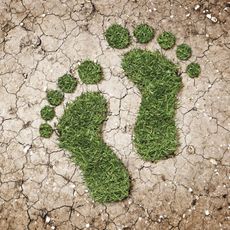 Does Gardening Reduce Carbon Footprint Size?
Does Gardening Reduce Carbon Footprint Size?If you’d like to learn how to reduce your carbon footprint on the Earth, start with your garden activities and planting decisions.
By Bonnie L. Grant
-
 How To Use Less Plastic: 5 Ways To Go Greener In Your Garden
How To Use Less Plastic: 5 Ways To Go Greener In Your GardenData on how our overuse of plastic is harming the planet may leave you wondering how to use less plastic. Here are ideas for reduced plastic use in the garden.
By Teo Spengler